Island Stories:
![]() Danzig
Mine
Danzig
Mine
![]() Zeballos
Iron Mine
Zeballos
Iron Mine
![]() Conuma
Peak 1910
Conuma
Peak 1910
Alexandra Peak
Argus Mountain
Bate/Alava Sanctuary
Beaufort Range
Big Interior Mtn
Big Interior Mtn 1913
Part 1
Part 2
Bolton Expedition 1896
Cliffe Glacier
Clinton Wood
Comox Glacier
Comox Glacier 1922
Comox Glacier 1925
Comstock Mtn
Conuma Peak
Copper King Mine
Crown Mtn
Elkhorn 1912
Elkhorn 1949
Elkhorn 1968
Eugene Croteau
Golden Bullets
Golden Hinde 1913/14
Golden Hinde 1937
Golden Hinde 1983
Harry Winstone Tragedy
Jack Mitchell
Jim Mitchell Tragedy
John Buttle
Judges Route
Koksilah's Silver Mine
Landslide Lake
Mackenzie Range
Malaspina Peak
Mariner Mtn
Marjories Load
Matchlee Mountain
Mount McQuillan
Mt. Albert Edward
Mt. Albert Edward 1927
Mt. Albert Edward 1938
Mt. Becher
Mt. Benson 1913
Mt. Benson
Mt. Doogie Dowler
Mt. Colonel Foster
Mt. Hayes/Thistle Claim
Mt. Maxwell
Mt. Sicker
Mt. Tzouhalem
Mt. Whymper
Muqin/Brooks Peninsula
Nine Peaks
Queneesh
Ralph Rosseau 1947
Rosseau Chalet
Ralph Rosseau Tragedy
Rambler Peak
Red Pillar
Rex Gibson Tragedy
Sid's Cabin
Steamboat Mtn
Strathcona Park 1980's
The Misthorns
The Unwild Side
Victoria Peak
Waterloo Mountain 1865
Wheaton Hut/Marble Meadows
William DeVoe
Woss Lake
You Creek Mine
Zeballos Peak
Other Stories:
Sierra
de los Tuxtlas
Antarctica
Cerro del Tepozteco
Citlaltepetl
Huascaran
Mt. Roraima
Nevada Alpamayo
Nevada del Tolima
Nevado de Toluca
Pico Bolivar
Popocatepetl
Uluru/Ayers Rock
Volcan Purace
Volcan San Jose
Biographies
Island 6000
Cartoons
Order the Book
Contact Me
Links

Mount
Whymper:
Highest
South of the 49th
by Lindsay Elms
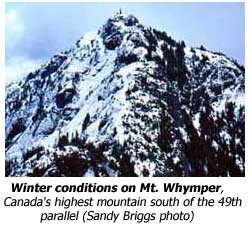 On
Southern Vancouver Island in the upper reaches of the Chemainus River
and a little north of Lake Cowichan stands Mount Whymper. Surrounded by
towering Douglas fir and cedars, crystal clear lakes and turbulent rivers,
Mount Whymper is a beautiful looking mountain when viewed from the Chemainus
Valley but a rather unassuming mountain compared to many of the island's
more well-known peaks. With a height of 1,541m Mount Whymper has the pretentious
honour of being the highest mountain in Canada south of the 49th parallel.
A trivial fact which for the climbing fraternity gives the mountain unique
credentials and makes it an alluring climb. The name Whymper is also of
significance in the historic sense and is linked with the "Golden
Age" of alpinism albeit in an indirect way.
On
Southern Vancouver Island in the upper reaches of the Chemainus River
and a little north of Lake Cowichan stands Mount Whymper. Surrounded by
towering Douglas fir and cedars, crystal clear lakes and turbulent rivers,
Mount Whymper is a beautiful looking mountain when viewed from the Chemainus
Valley but a rather unassuming mountain compared to many of the island's
more well-known peaks. With a height of 1,541m Mount Whymper has the pretentious
honour of being the highest mountain in Canada south of the 49th parallel.
A trivial fact which for the climbing fraternity gives the mountain unique
credentials and makes it an alluring climb. The name Whymper is also of
significance in the historic sense and is linked with the "Golden
Age" of alpinism albeit in an indirect way.
Mount Whymper is named in honour of Frederick Whymper, a talented artist and stalwart explorer. Frederick Whymper (1838 - 1901), the son of Josiah Wood Whymper, a well known English wood-engraver, arrived on Vancouver Island in the fall of 1862. The following year he travelled throughout British Columbia and made sketches of the Cariboo gold-fields and then in the spring of 1864 the entrepreneur Alfred Waddington hired Whymper to make sketches of Bute Inlet and the Homathco Valley. Waddington had envisioned building a road from Bute Inlet on the coast to the Cariboo gold-fields of British Columbia thereby opening the floodgates to the wealth of the interior. This route would be shorter then the road through the treacherous Fraser Canyon from New Westminister and was proclaimed a profitable enterprise as it would open up hundreds of thousands of acres for ranching.
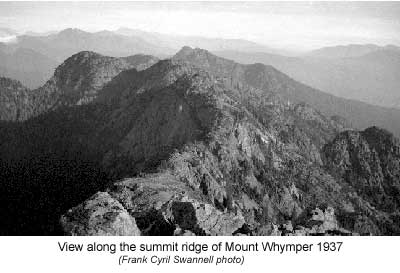 As
well, it would secure for Victoria the commercial supremacy, which New
Westminister threatened to take away. However, the threat of smallpox
to the Indians led to a surprised massacre by the respected though feared
Chilcotin war chief Klatassine. Whymper had left the road builders camp
up the Homathco the day before the massacre and was waiting on the coast
for a canoe to take him to Victoria when he heard rumours about the incident.
Upon arriving in Victoria in early May, Whymper attracted much attention
from those seeking news of the reported massacre, but it wasn't until
three survivors arrived in Victoria a week later that Waddington's complacency
in dealing with the situation was shattered by the horrible details of
the massacre. This raised a feeling of alarm among all the settlers in
the outlying districts.
As
well, it would secure for Victoria the commercial supremacy, which New
Westminister threatened to take away. However, the threat of smallpox
to the Indians led to a surprised massacre by the respected though feared
Chilcotin war chief Klatassine. Whymper had left the road builders camp
up the Homathco the day before the massacre and was waiting on the coast
for a canoe to take him to Victoria when he heard rumours about the incident.
Upon arriving in Victoria in early May, Whymper attracted much attention
from those seeking news of the reported massacre, but it wasn't until
three survivors arrived in Victoria a week later that Waddington's complacency
in dealing with the situation was shattered by the horrible details of
the massacre. This raised a feeling of alarm among all the settlers in
the outlying districts.
At the same time in Victoria, the Vancouver Island Exploring Expedition (VIEE) committee was looking at hiring men to assist Dr. Robert Brown in exploring and mapping Vancouver Island. Whymper was immediately appointed as the expeditions artist and spent the summer of 1864 exploring Southern Vancouver Island.
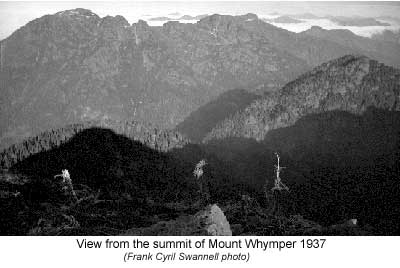 He
made thirty-three beautiful pencil and watercolour drawings which went
on display in the Government Buildings on Nov. 28, 1864. Whymper never
stayed for the second Expedition in 1865 led by John
Buttle, who had also been employed by Waddington in the Homathco
Valley, but continued travelling throughout North America and in 1868
he wrote Travel and Adventure in the Territory of Alaska which
published his account of part of the Vancouver Island Expedition.
He
made thirty-three beautiful pencil and watercolour drawings which went
on display in the Government Buildings on Nov. 28, 1864. Whymper never
stayed for the second Expedition in 1865 led by John
Buttle, who had also been employed by Waddington in the Homathco
Valley, but continued travelling throughout North America and in 1868
he wrote Travel and Adventure in the Territory of Alaska which
published his account of part of the Vancouver Island Expedition.
Although the Vancouver Island Exploring Expedition and Frederick's subsequent journeys were of valuable geographical interest his exploits were unfortunately overshadowed by his younger brother Edward. Edward Whymper was to become the most famous mountaineer from the Victorian era when he made the first ascent of the Matterhorn in July 1865.
The mid 1850's to the end of the 1860's marked the start of modern mountaineering as a sport in its own rights. This period became known as the "Golden Age" of alpinism.
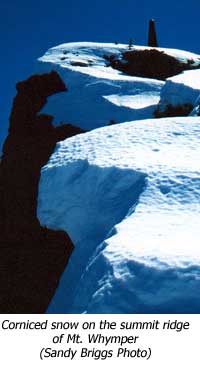 There
was an explosion of activity, with climbers from the emerging middle class
beginning to go regularly to the "Playground of Europe," the
Alps, for their annual holidays, exploring the passes and tackling the
higher summits. During this time Vancouver Island was still considered
a "wild and savage country" as there were large tracts of unexplored
land.
There
was an explosion of activity, with climbers from the emerging middle class
beginning to go regularly to the "Playground of Europe," the
Alps, for their annual holidays, exploring the passes and tackling the
higher summits. During this time Vancouver Island was still considered
a "wild and savage country" as there were large tracts of unexplored
land.
No one had even thought about climbing as the higher mountains of the island's interior had not been seen yet. By the end of the 1850's most of the 4,000m peaks in the Alps had been climbed but there was still one sort after prize - the picturesque Matterhorn.
Located on the border of Italy and Switzerland, the Matterhorn had seen numerous attempts by local guides to reach its airy summit. Edward Whymper, an artist like his brother Frederick, was commissioned to make drawings of the Alps for the second edition of Peaks, Passes and Glaciers, the guidebook to the Alps.
Whymper had never even seen a mountain before but in the summer of 1861 he saw the Matterhorn for the first time and immediately made an attempt to reach its pinnacle. By the best mountaineers at the time the Matterhorn was claimed to be impossible to climb.
Whymper's attempt ended in defeat, much to the relief of the local guides, but this merely increased his resolve to conquer the mountain. For the next three years Whymper continued his attempts but it wasn't until the summer of 1865 that he managed to reach the summit along with six companions.
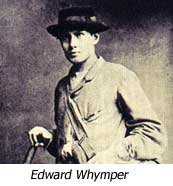 On
the descent a climber from the triumphant party slipped and pulled three
of his companions with him. The rope snapped and four of the first seven
men to climb the Matterhorn plunged down the abyss to their deaths. Fortunately
Edward Whymper was one of the survivors.
On
the descent a climber from the triumphant party slipped and pulled three
of his companions with him. The rope snapped and four of the first seven
men to climb the Matterhorn plunged down the abyss to their deaths. Fortunately
Edward Whymper was one of the survivors.
Whymper's fame spread far and wide and he travelled and wandered around the world writing about his adventures but the fateful events on the Matterhorn's summit were to haunt him for the rest of his life.
He was often called upon to give lectures on his ascent of the Matterhorn and his climbs in South America. In 1901 the Canadian Pacific Railway invited Edward Whymper to Canada and his visit was designed to be the most important promotion of the Rockies the railway had ever undertaken. It was also rumoured that Whymper had come to Canada to make the first ascent of Mount Assiniboine - the Matterhorn of the Rockies. However, Whymper harboured no interest in such a formidable ascent at the age of sixty-two.
Sometime between 1901 and 1905 Edward Whymper visited Vancouver Island and tradition has it he climbed Mount Arrowsmith which at that time was considered the highest mountain on the island. It is said that on the summit he built a rock cairn, which became known as Whymper's Cairn.
As the crow flies Mount Whymper is about forty-five kilometres from Mount Arrowsmith and on a clear day its summit is clearly visible. No doubt Whymper looked longingly in the direction of the mountain that bears his family name, but for whatever reasons, he never trod its summit. Nevertheless, the Whympers name will live on forever on the beautiful mountain.
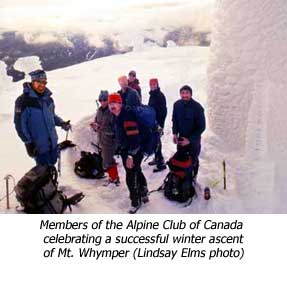 Today
Mount Whymper is a popular mountain for climbers as it is an easy day
trip from Victoria or Nanaimo. All its ridges have seen numerous ascents
in summer and it has become a fashionable trip to do in the winter on
skis or snowshoes. In the evenings when the sunsets with a fiery alpenglow
over the Pacific's western horizon the mountain casts a shadow over the
southern island that will remind local mountaineers of the "Golden
Age" of alpinism that opened up climbing for all classes of men and
women.
Today
Mount Whymper is a popular mountain for climbers as it is an easy day
trip from Victoria or Nanaimo. All its ridges have seen numerous ascents
in summer and it has become a fashionable trip to do in the winter on
skis or snowshoes. In the evenings when the sunsets with a fiery alpenglow
over the Pacific's western horizon the mountain casts a shadow over the
southern island that will remind local mountaineers of the "Golden
Age" of alpinism that opened up climbing for all classes of men and
women.
How to order | | About the Author || Links || Home
Contact:
Copyright ©
Lindsay Elms 2001. All Rights Reserved.
URL: http://www.beyondnootka.com
http://www.lindsayelms.ca